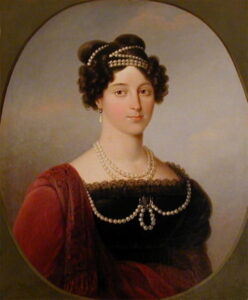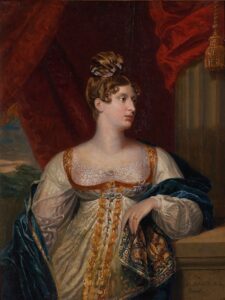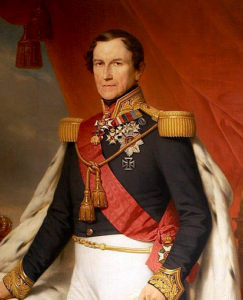From the New York Times bestselling author of The Romanov Sisters comes the story of a courageous young Imperial Grand Duchess who scandalized Europe in search of freedom. Read on for a featured excerpt from The Rebel Romanov.

PROLOGUE
The Coburg Marriage
In May 1816, at the Prince Regent’s Carlton House residence in London, an obscure German prince married the most sought-after royal bride in Europe – Princess Charlotte of Wales, second in line to the throne of Great Britain after her father, the Prince Regent. During the ceremony, held in the Crimson Drawing Room at 9 p.m., there had been barely stifled amusement – even to the bride herself – when, at the point when the couple exchanged vows, she heard her fairytale prince solemnly promise to endow her with all his worldly goods. For Charlotte knew full well that her new husband, Prince Leopold of Saxe-Coburg-Saalfeld, was the scion of a cash-strapped ‘Pumpernickel-Staat’, ‘a younger prince of Coburg [whose] whole income was only £200 sterling’. All Leopold had in reality to offer his bride beyond his seductive good looks and his distinguished military credentials were his guile and ruthless ambition.
Nevertheless, the ‘Coburg Marriage’ – as it was dismissively referred to by the British aristocracy – was no mean achievement for an unremarkable German principality that in the political scheme of things had long been ‘lost on the map of Europe’ and on which the press had until then been entirely silent. Leopold’s marriage to Britain’s favourite princess was an incredible coup for a minor European prince and brought the couple an annual allowance of £60,000 (over £6 million today), which was more than the entire annual revenue of his debt-ridden home country – a tiny, rural principality tucked away in central Germany. Its rulers could claim descent from one of the ancient European dynasties – the Saxon House of Wettin – that had once ruled much of the region, but successive divisions of the territory between the male heirs of the Ernestine branch had fragmented the region into a complex tapestry of domains subject to periodic reshuffling. Saxe-Coburg-Saalfeld in fact comprised two small territories that were geographically separated: Coburg, the dynastic seat, lay in Upper Franconia just south of the Thuringian Forest while Saalfeld, which lay on the other side of the forest in the principality of Schwarzburg, was added through marriage and purchase in 1699.
By 1801, the status and power of Saxe-Coburg-Saalfeld had atrophied considerably, leaving it shackled by debt and reduced to a combined military strength of only 150 musketeers and grenadiers and a militia of one battalion of 360 men. Much of this debt had been the result of profligate spending and mismanagement of the Coburg coffers by successive dukes, who had ruled the region along old feudal lines.
During the terrible depredations wreaked across Europe in the Napoleonic Wars, Saxe-Coburg-Saalfeld was caught in the crosshairs, a perpetual victim of incursions by transient Napoleonic troops; for a while, the ducal family had had to flee their capital for the safer location of Saalfeld. Nevertheless, Leopold and his two brothers Ernst and Ferdinand had ‘exerted themselves, as far as they were able, for the emancipation of Germany’ in the final push against Napoleon during 1813–14: Ernst with the Prussians in Berlin, Ferdinand with the Austrians in Vienna, and Leopold in service to Emperor Alexander I of Russia in Poland.
As the youngest son of a duchy that had adopted the law of primogeniture, and who was thus well down the pecking order below his two older brothers, Leopold needed to seek his fortune abroad and it was Russia that had set him on the ladder. His military record had been exemplary: enrolled as an honorary cadet in the Russian Imperial Guard at the age of five by Catherine the Great, Leopold’s advancement thereafter, as the first German prince to join the Russian army, had been meteoric. In 1810, he had resigned under pressure from Napoleon but was reintegrated in the Russian forces by May 1813, after which he led his regiment of Russian cuirassiers in cavalry charges against French forces at the battles of Lützen and Bautzen in Saxony and scored his most significant military success at the battle of Kulm on 30 August. By this time, Alexander I and his Prussian and Austrian allies had all acknowledged the merit of Leopold’s services, and ‘six or eight Orders were conferred on him’, including the prestigious order of St Alexander Nevsky and the crosses of St George and Maria Theresa and the Iron Cross of Prussia for his role at Kulm.
Prince Leopold was also present at the military engagement outside Paris on 31 March 1814 that saw the final defeat of Napoleon, an honour that brought him in the victors’ parade into Paris itself and on to England that June with the allied sovereigns of Prussia and Russia. When he arrived in London, Leopold, who couldn’t afford a hotel and was staying above a grocer’s shop in Marylebone, was already pondering a game plan that had been sown in his mind by the tsar. Having had to abandon his ‘fruitless passion’ for Empress Josephine’s ‘pale, pensive and spirituelle’ daughter, Hortense de Beauharnais, he found himself now in pursuit of ‘a ruddy buxom girl, more German, perhaps, in her appearance than Leopold could have wished’. For Alexander had apparently informed Leopold privately not long before they left for England that ‘I intend for you to marry Princess Charlotte, the future Queen of England.’ Alexander’s clever widowed sister, Ekaterina Pavlovna, Duchess of Oldenburg, who was then staying in London, took the plan to the next level. She befriended Princess Charlotte and contrived a meeting between the classically tall and dark Leopold and the boisterously endearing eighteen-year-old princess. This unwished-for encounter, as far as he was concerned, would soon turn the Prince Regent’s own dynastic ambitions for his daughter upside down, as well as providing Russia with an important influence at the British court in the person of Leopold.

Charlotte had recently broken off her engagement to her father’s choice of husband, the affable but dull Prince Wilhelm of Orange. She had reluctantly agreed to the engagement in December 1813 in the cause of a strategic Dutch–British political alliance, but had then been distracted by a short-lived passion for Prince Friedrich of Prussia. When this fizzled out, attempts were made to steer Charlotte back in the direction of the Prince of Orange but she had resisted this on discovering that, as wife of the heir to the Dutch throne, she would have to live in the Netherlands for most of the time. In any case, by the summer of 1814, the ambitious Leopold – whom even Napoleon had remarked upon as being ‘one of the handsomest young men I ever saw’ – had arrived at court and had begun to work his charm on her.
By this time, Charlotte was growing increasingly rebellious, desperate for release from her father’s stifling control; her liking for ‘Der Leo’, as she affectionately called him, soon turned to fascination and then to a very determined passion. By early 1815, and despite the Regent’s stubborn opposition, she had become convinced that of all the many suitors for her most eligible hand, Leo was the one who ‘from his situation & everything I have heard of him is the most elagible [sic] connexion for me now . . . I delight in Coburg because I am quite satisfied he is really, truly & sincerely attached to me & very much so desirous to the greatest degree to [do] all in his power to make me happy.’ Charlotte, who was notoriously headstrong and called the shots as the only legitimate child in line to the throne at that time, refused to give him up.
Leopold’s German ducal credentials might not have been grand enough for the English royals, but at least he was from a ruling family, and no one could doubt the good prince’s moral and intellectual character, his ‘dignified gravity and unusual moderation’, though privately the Prince Regent found his putative son-in-law cautious and pedantic, and later nicknamed him ‘Marquis Peu-à-Peu’. But there was more to Leopold than initially met the eye: a cold intellect and logic lurking beneath the ingratiating façade, indicative of a determination to advance the interests and ascendancy of the Saxe-Coburgs in Europe. For her own part, Charlotte had no intention of allowing this unequal royal match to diminish her: ‘Do not imagine that, in marrying Prince Leopold, I ever can or will sink to the rank of Mistress Coburg. Entertain no such idea, I beg of you.’ She was already intimating her intention, when the time came, of seeing her German husband elevated beyond the role of mere consort, an aspiration nursed by Leopold himself. For, as the English diarist Henry Greville observed, he ‘would do anything to be beking’d’.
When news broke on 10 February 1816 that ‘notice ha[d] been sent to the Court of Coburg of an intended union between the Princess Charlotte of Wales and Prince Leopold of Saxe-Coburg, third son of the reigning Duke’, Leopold was so little known in England that even these basic facts were wrong. His father had died in 1806 and his brother Ernst was now on the throne. The British aristocracy were contemptuous: ‘He is after all but a petty Prince for the heiress to the British throne,’ sneered Lady Charlotte Campbell Bury. Yet for all that, the Coburg marriage was ‘the only genteel Topic of Conversation’ in London society at the time. It wasn’t until November that anyone was the wiser, when Frederic Shoberl’s Historical Account of the House of Saxony, containing a chapter on Saxe-Coburg-Saalfeld, was brought out for public consumption, outlining the prince’s illustrious genealogy and career.
***

Leopold arrived at Dover by packet boat from the Continent on 19 February 1816 for his wedding to Charlotte. Until the ceremony on 2 May, he stayed at the Clarendon Hotel in New Bond Street, a respectable venue for ‘single gentlemen’. Public curiosity had been ‘wound up to the highest pitch’ by the time Leopold, dressed in his splendid general’s ‘regimentals’ – having been newly elevated to that rank by the Prince Regent – gratified the eager throngs waiting outside Clarence House by making his appearance to the sound of their ‘stentorian huzzas’. But the congregation for the wedding at nearby Carlton House was small by royal standards. Only fifty hand-picked dignitaries – foreign ambassadors, cabinet ministers, and members of the British royal family and nobility – were in attendance. No foreign royalty were there, nor even the bride’s mother – from whom the Regent was estranged. Travel in the days before the railways was slow and difficult; Prince Leopold’s scattered family was represented by the Saxon minister in London, who signed the marriage certificate, for nobody from Leopold’s home country was present to witness this moment of triumph for the House of Saxe-Coburg-Saalfeld.
Not least among the absentees was Leopold’s older sister Julie, for she it was who, through her own politically strategic marriage to Catherine the Great’s grandson Grand Duke Konstantin in 1796, had made all this possible. For that union had brought exceptional honours and preferment not just to Leopold but to the whole family; more importantly, it had brought Saxe-Coburg under the protective wing of the Russian Empire. Julie, the beloved sister, sacrificed on the altar of dynastic expediency in a strange, foreign land at the age of only fourteen, had given a huge boost to the military careers of all three of her brothers, and with it the family’s favour with the Romanovs. She had been the first of the seven Saxe-Coburg siblings – the surviving children of Duke Franz and Duchess Auguste – to wed; between 1796 and 1818 they achieved a spectacular succession of marriages that turned this obscure family into the king- and queenmakers of post-Napoleonic Europe, placing their progeny ‘upon thrones, next to thrones, or behind thrones’.
By the time of his marriage, Leopold was already on the high road to international power and influence. Coburg, that insignificant ‘archipelago of princes’, as Catherine the Great’s lover Prince Grigory Potemkin had once scornfully referred to it, achieved yet more dynastic success that same year, when Leopold’s brother Ferdinand married the daughter and sole heir of the wealthiest man in the Austrian Empire. A sister, Antoinette, was installed in the Russian court not long after Julie as the wife of Duke Alexander of Württemberg, brother of the German-born dowager empress. But it was the youngest sister, Victoire, who in 1818 scored the ultimate triumph by marrying Princess Charlotte’s uncle and a son of King George III, the Duke of Kent. A year later, she gave birth to a future monarch – Queen Victoria – who would bring the Saxe-Coburg story full circle in 1840 by marrying her first cousin, Prince Albert of Saxe-Coburg and Gotha.
It is not surprising, therefore that few were aware then, as is the case even today, of the existence of the lost Saxe-Coburg sister, Princess Juliane Henriette Ulrike, who set in train the inexorable rise of the Coburgs. By 1854, Julie’s story, such of it as was known even then, had reached the levels of myth: ‘Who was this modern Iphigenia? – this Ariadne given up to the Minotaur? – this Andromeda whom no Perseus came to rescue?’ thundered the Dublin Weekly Nation in an excess of indignant hyperbole. ‘You’ll search for her in vain in any list of the Russian royal family. For Heaven’s sake, who was she?’ For the world knew nothing of this ‘poor doomed rosebud’ who had been ‘torn from the nursery’ to further the Saxe-Coburg cause; nor of the high personal price she had had to pay in the cause of her mother Auguste’s overweening ambitions in securing her marriage into the Russian imperial family. As historian Johann Heinrich Schnitzler observed: ‘Such was the attraction of an imperial crown, that it overbalanced love of country, attachment to religious faith, and the apprehension which the state of things in Russia might then well cause.’
Uprooted from her quiet and uneventful life in Coburg and abandoned unceremoniously, alone and friendless, in Catherine the Great’s St Petersburg, Julie was stripped of her German birth name, which was supplanted by the alien, talismanic title of Grand Duchess Anna Feodorovna of Russia, or the even more anonymising Grand Duchess Konstantin. But among her family, she was always known as Jülchen – ‘little Julie’ – and the affectionate form of her name extended even to Queen Victoria, who spoke very fondly, and often, of her dear aunt ‘Julia’ and never referred to her by her Russian name. We shall use ‘Julie’ throughout this narrative, which charts the span of her difficult, elusive and often tragic life, much of it lived effectively as an exile, in avoidance of gossip and scandal.
